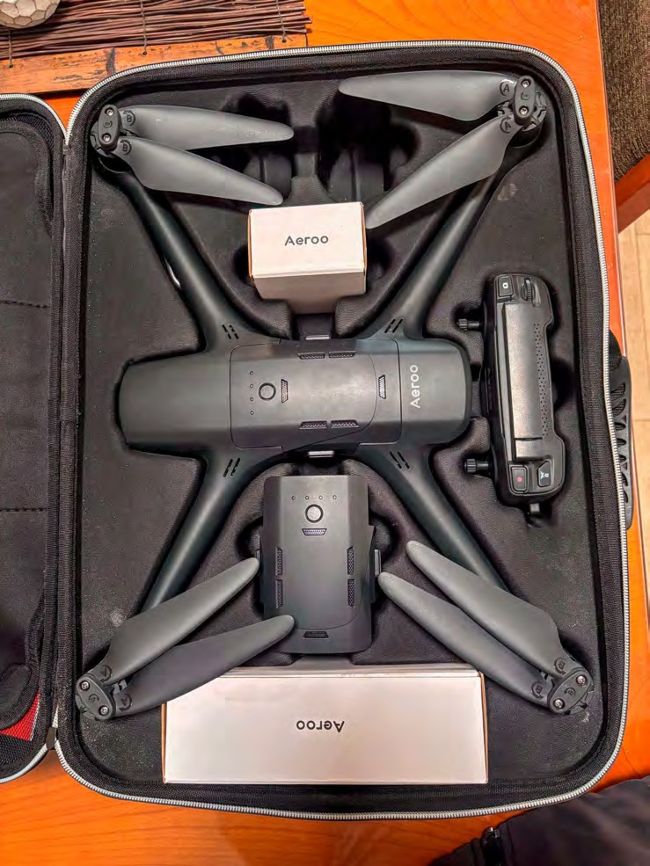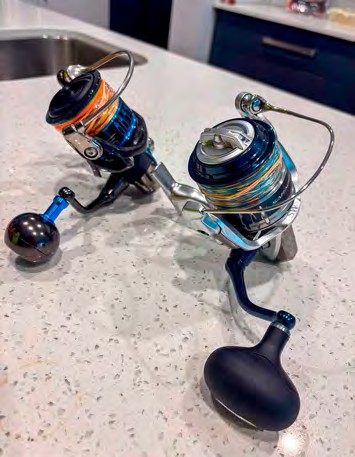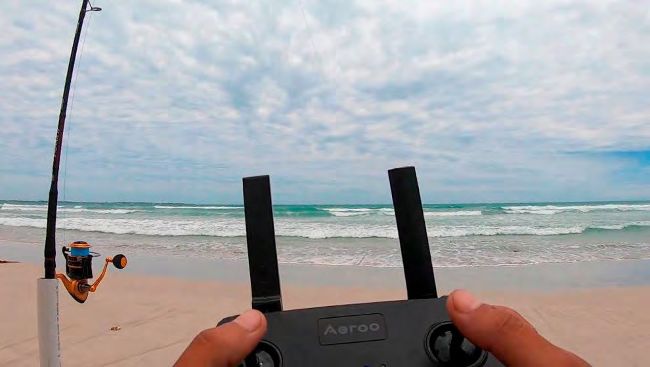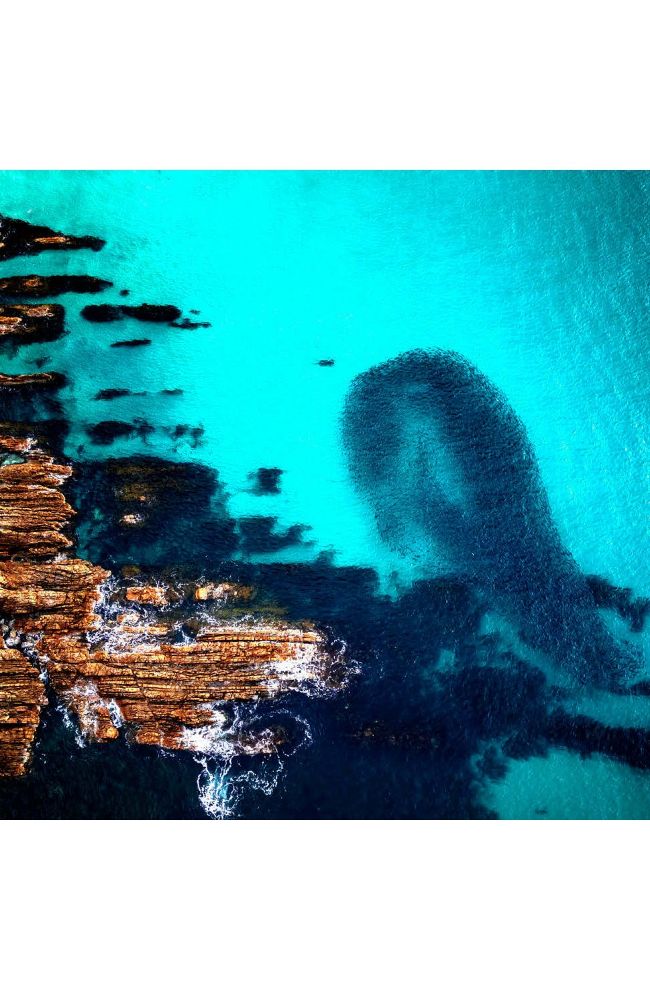HOOKED FROM ABOVE
Drone fishing in South Australia
Jordan Saliba examines this exciting new way to go fishing. Drones may just be the way of the future!
Fishing has come a long way from the simple rod and reel. These days, everything is about the new and improved versions of the old school methods, which has been accelerated by the progression of technology. More often than not, we anglers go to a spot and are limited to only a certain zone we can cast into, but that has all recently changed with some awesome technology. Yep, you guessed it, drone fishing!
Although fishing drones have been a thing for a little while, the new technology and designs with drones in this age have gone to a whole new level. From dropping a bait far beyond the surf to visually scouting for dream fish from the sky, drones have revolutionised the way we approach fishing.
In this article I’ll break down everything, from how drone fishing works, why it’s gained popularity, the best type of fishing drones, some tips and tricks on drone fishing in SA, and my personal experience so far with my Aeroo Pro fishing drone.
LEGAL CONSIDERATIONS AND REGULATIONS
Before you dive into the world of drone fishing, it’s very important to understand the legal side of drone fishing in South Australia. Here are some things to make sure you are aware of.
Number one is that recreational drones must stay under 120m in altitude and always remain within a visual line of sight. So, even if your drone can fly 10km in range, you do not have the right to fly it too far offshore if you cannot see it.
Number two is be mindful of No-Fly zones and restricted airspace. In SA many areas are off-limits for drones, and among them is national parks, which have some great fishing spots. So just double check with the laws and regulations in your area before sending your drone up!
You may also consider getting some certifications if you are flying drones over 2kg or using one for charter fishing purposes.
WEATHER AND CONDITIONS
Weather is such a crucial factor for drone fishing, so checking the conditions in detail before takeoff is essential. Unlike traditional fishing, where a little bit of wind and rain isn’t a complete dealbreaker, drones are not to be toyed with when battling the elements. Things to consider are wind speed and direction, rain and moisture, temperature, and time of the day.
Let’s start with wind. Wind is one of the biggest challenges when drone fishing, as even moderate winds can make it challenging to fly out baits too far. However, with the improvement of fishing drones over the years, many drones such as the Aeroo Pro which I use, have been built to fly in winds up to 40-50km/h. However, even though the drone can fly in these conditions, you need to be aware that battery life will decline quicker, as the drone is working a lot harder to resist the wind.
Wind direction is also super important, as an offshore breeze can push your drone out to sea if you catch a bad weather window. This will make it a lot harder to fly the drone back to shore as you need to fight the wind. Luckily, with the technology on some drones these days, they have an AI battery, which knows when to fly back into shore to ensure you have enough battery life to make it back to your home point safely.
A great app to check the wind is Windy, which I religiously use and is extremely accurate on wind speed and direction in specific areas. It also considers sheltered zones and open areas, so it’s very handy to use on those windier days to ensure you have a great experience.
Rain is a drone’s worst enemy. Most fishing drones are not waterproof, so even a slight sprinkle of sea water can be enough to do some serious damage to the electronics and cause malfunction. Another thing to be mindful of is not flying your drone to close to the water’s surface, especially if there is high swell and waves. I have heard of way too many people losing their drones to a big splash due to flying too low!

The Aeroo Pro drone packs away neatly into a compact case
Flying in hot conditions isn’t a complete deal-breaker, but doesn’t make it easy for your drone. The hotter it is, the harder the battery is working so you can expect short battery life on these days, which may affect how many drops you can do. I wouldn’t recommend flying in anything above 35 degrees, but the ideal temperature would be between 20-25 degrees. Lastly, choose the times carefully. As mentioned before, flying your drone out of visual site is prohibited, so flying at night time is not a great idea. Just try and be careful and consider the first light and last light times using your weather app.
My final advice is to fly on low-wind, dry days with a temperature between 20-25 degrees and make sure you do your weather research beforehand!
CHOOSING THE RIGHT DRONE FOR FISHING
Picking the right drone for fishing depends on your needs, budget and the conditions/areas you’ll be fishing in. However, there are two main types of drones — consumer drones and dedicated fishing drones.
Consumer drones, like the DJI Mavic and Phantom series, are examples of consumer drones which are mainly used for videography purposes. But you can also buy third-party bait release systems for these drones. While these drones are very capable, they are not specifically built for fishing and their payload and weather resistance isn’t as great.
Dedicated fishing drones, such as the SwellPro and Aeroo, have been purposely built for fishing. These models come with built-in bait release systems, higher wind resistance, stronger payload and, in some cases, added waterproofing for durability.
When choosing a drone, I think the payload capacity and battery life are something to look for. I personally use the Aeroo Pro, has a 1kg payload, 45-minute fly time on each battery, GPS and smart AI features to ensure flight safety.
So, whether you are after a versatile consumer drone or a dedicated fishing machine, make sure you choose the right one for your specific needs to up your fishing game.
ESSENTIAL GEAR AND SET-UP
Having the right gear is just as important as choosing the right drone. So, in this part we are going to talk about rods, reels, line and essential tackle and gear.
Rods for drone fishing need to be strong, tall and flexible enough to handle a long-distance bait drop. I would say a 12–14-foot rod is ideal, as it provides enough height to keep the line well clear of waves and offers the strength to handle bigger fish such as mulloway or sharks. I use a 12ft Daiwa Seabass, which has a strong backbone that allows me to have the power when fighting fish from afar.

Clipping line into the release mechanism
When it comes to reels, you have two options – spinning or overhead. If you are just a beginner, I would recommend a 10,000 size or larger spinning reel, which is a user friendly and versatile option. But if you are a more seasoned angler, I would suggest looking at some overhead reels that offer better line control and higher line capacity so you can get out to those real untouched areas off the surf.
Braided line is the go-to choice due to its thin diameter, high strength and minimal stretch, which helps with longer bait-drops. However, a lot of anglers using overhead reels will opt for monofilament, which is great for shock absorption and reducing visibility in the water.

Large capacity threadlines are a popular option
If you are just targeting mulloway or small sharks, you can probably get away with 5080lb braid, but if you are targeting proper beasts, you may consider something heavier.
Tall rod holders are a must-have for drone fishing to ensure you keep your setup secure while waiting for a bite. It can also help keep the bait in a good position and avoid easy snags and getting busted off when you hook up.
Choosing the right hooks is also very important. I swear by circle hooks when drone fishing, as you can just set and forget your rod and trust the circle hook will pin the fish in the corner of the mouth, allowing for an easy release if needed.
BAIT OPTIONS
When it comes to drone fishing, both live and dead bait have their advantages, and this depends on the species you are targeting and the conditions. Live bait is often the best choice for predatory fish like kingfish, mulloway and tuna, as the movement attracts a strike. The best live baits are whatever is in the area that the big predatory fish are feeding on, which may be salmon, mullet etc. However, sometimes catching live bait can be a challenge so it’s good to come prepared with dead baits.
Dead baits are much easier to manage and can still be highly effective. Fresh squid strips, whole pilchards, whole squid and mullet are great choices which all offer strong scent trails to attract that dream catch. If you are targeting sharks, going for a whole bonito or mackerel will work wonders for you.
BEST DRONE FISHING TECHNIQUES
Using the right rig can make all the difference when drone fishing. The running sinker rig is one of the more popular set-ups, but the paternoster rig can also be effective. For targeting larger fish, a paternoster rig with two hooks can increase your chances of a bite, whereas when fishing for sharks, a sliding trace rig with a wire trace is essential to prevent bite-offs.

A lovely samson caught from the beach with a Aeroo Pro drone
If you would like to see how I use the paternoster rig, you can head over to my YouTube channel @JordanSAFishing and watch my video on drone fishing, where I give lots of handy tips!
Choosing the right area to fish is crucial. This is made a lot easier with drones, as they have the camera which allows you to select the perfect zone and identify structure and drop-offs. You can also utilise it to spot schools of fish such as salmon, which will school up into big balls and are easy to spot from above.
If you see dark patches of reef, sand holes or areas with strong current lines, these are all prime fishing zones and will hold fish.
With these high technology drones you can use the GPS feature to mark spots and save your past bait-drops. So, if you find a great reef, saving those coordinates is an awesome way to keep your drops consistent and know you’re fishing a good spot.
BEST SPOTS ISN SA
South Australia isn’t exactly well known for its drone fishing, but I also think it’s a very untouched subject waiting to explode. The Yorke Peninsula, Eyre Peninsula and Fleurieu Peninsula all offer some exciting opportunities to drone fish.
If you are looking to chase some sharks off the surf, Aldinga Beach and Goolwa Beach are great beginner-friendly spots to give a go. For those looking to target those trophy species such as mulloway, I have had great reports out of Goolwa Beach, Long Beach and the Far West Coast if you are keen for the drive!
I think the great thing about drone fishing is you can explore different spots and find your own little honey holes. So don’t be shy in trying new areas and searching for that new favourite spot!
DRONE MAINTENANCE AND TROUBLESHOOTING
Okay, now you’ve gone out and caught your dream fish, but this next step is where a lot of people go wrong. After you get home from a trip it is vital that you clean your drone and give it a quick vacuum in case there are sand particles in the electronics. Make sure you recharge the batteries as soon as possible to avoid damage and update firmware if needed!

An eagle ray hook-up with a droned bait
Spending 10-25 minutes on doing this after each session will increase the life and durability you get out of your drone significantly.
MY EXPERIENCE WITH THE AEROO PRO FISHING DRONE
In December last year I drove down to the remarkable Limestone Coast to test out my Aeroo Pro drone at Long Beach. It started off with a fun drive along the beach with my 4WD until we eventually found a nice gutter we were intrigued by.
The conditions were perfect, with a slight offshore breeze, mid 20 degrees and a perfect incoming tide which would reach high around sunset.
After we had set up our rod holders, we made up some two hook paternoster rigs with circle hooks and a surf sinker at the end. We then attached a 1.5 leader to the top swivel, which was then connected to the bait release system on the drone. With all safety things considered, it was time for lift off!

Learning to fly is easy
Using the camera on the drone, I was able to find a great little sand hole about 150-200m from shore, which is where we decided to drop a fresh trevally fillet we had harvested that morning from the Robe marina.
Within 20 minutes I noticed my rod in full extension and my reel spinning screaming, which I knew could only mean one thing. Hooks set and feet planted into the sand, I was truly into the fight, which what I hoped to be a mulloway!
Mid way through the fight I started to notice very minimal headshakes and my concerns grew that it may have been some sort of stingray or undesired catch. And yep, it happened to be a little eagle ray. Bummer! But this only enhanced my motivation to get the next bait out there and increased my curiosity of what this little flying machine can achieve. So, I have some unfinished business!
CONCLUSION
Drone fishing is an exciting and innovative way to take your fishing game to new heights! Hopefully, in this article you have gained some good understanding of what it means to drone fish in SA and how it can maximise your success. If you have any questions or concerns, feel free to direct message my Instagram @JordanSAFishing or check out my YouTube channel @ JordanSAFishing, which is where you can watch my drone fishing adventure.

Drones are fantastic for locating surf salmon schools
Until the next one, tight lines, legends!